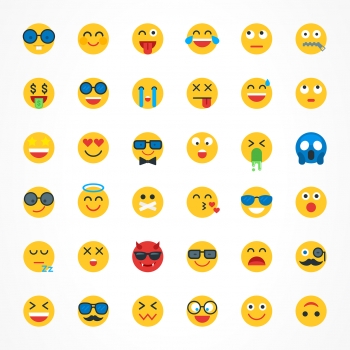Keep smiling – the history of the emoji
(Posted on 14/07/21)

As this Saturday (17 July), is World Emoji Day we couldn’t help but wonder, when did the little sphere of yellow joy first appear? And how did it evolve into such a plethora of expressions and graphics most of us use every day?
How it all began…
Although smiley faces have been drawn throughout history, some of the first computer users will remember emojis as ‘emoticons’. Sounding a little like something from Transformers, emoticons were also a product of the 80s, first appearing in emails in 1982. Emoticons are textual faces created by using typed characters to form an expression, such as :-) or ;-) or :-( and :-D. Computer scientist, Scott Fahlman, is credited with sharing the first emoticon, as a way of exploring using text to portray emotions.
Emoticon was later shortened to ‘emote’, and they were also nicknamed ‘smileys’, as The Smiley Company began creating emoticons as graphical faces in 1996. This began to replace the text style as more expressions and designs could be created and shared.
A cultural phenomenon
The word ‘emoji’ originates from Japan, when they first began to appear on Japanese mobiles from 1997. It literally means ‘picture character’ – it’s just a happy coincidence that the word looks similar to emotion and emoticon.
Emojis then became increasingly popular from 2010 after several mobile operating systems added them worldwide, including Apple and Android. However, each provider had their own set of different emojis, which sometimes caused issues when messaging others on a different network, causing the emoji to fail to appear and only show as a rectangular box. To solve this problem, textual unifiers, the Universal Coded Character Set (Unicode), stepped in to stop the discrepancies, and all emojis are now approved and issued through this system.
Say it with emojis
Most emojis used today can be traced to the start of the Unicode set in 2010. As more and more emojis were created and added, the word entered into popular lexicon, and was officially included in the Oxford English Dictionary in 2015. In fact, to much controversy, its ‘Word of the Year’ was named as the laughing crying face emoji! Most importantly for us here at Zebra, the emoji for a zebra was first created in 2017.
The emoji today
As the usage of emojis has grown across the world, they are used for so much more than just to show reactions and emotions. Many people use them as a replacement of language in their messages, and the range of emojis incorporates a wider selection than the original round smiling faces – from a diverse mix of nationalities and genders to food, mythical creatures, cultural symbols and many others.
Some emojis have also been used to raise awareness of particular issues. Often on social media, especially Twitter, hashtags can be added to or even replaced with an emoji, to highlight certain international campaigns and awareness days. This includes #InternationalWomensDay featuring the feminine symbol, #EarthDay with a seedling symbol and #WorldEmojiDay represented by the calendar icon.
Why World Emoji Day?
The 17 July is famously highlighted on the emoji for a calendar, which is the reason why this date was chosen to celebrate the emoji world-wide. World Emoji Day is also the opportunity for people to vote for their favourite emojis, or emojis which most sum up the year, in the World Emoji Awards. The #Most2021Emoji has sadly seen the microbe, DNA, masked face, and syringe feature in the online polls, revealing the world’s ongoing focus on Coronavirus.
What next for emoji?
2022 is expected to see 107 new emojis joining the list, which could take the total number of emojis to 3,460. With Apple also having historically used World Emoji Day as an opportunity to showcase the next set of emojis to appear for the next year, we will be interested to see which new emojis might be appearing on our phones to share and smile at.
Emojis have come a long way since their humble beginnings. So, which is your favourite emoji? Tag us on social and let us know! #WorldEmojiDay







